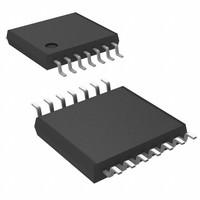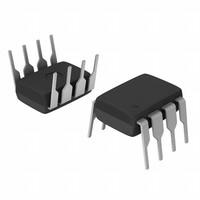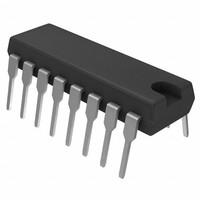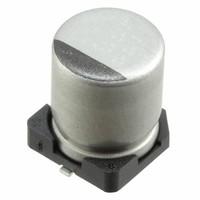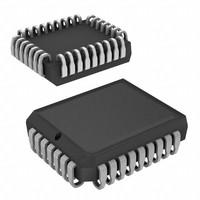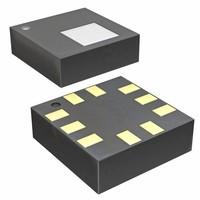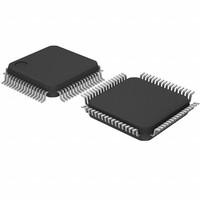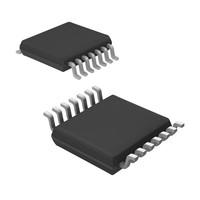
UC3842 Vs UC3843 Vs UC3844 Vs UC3845 PWM Controller: Datasheet, Circuit Diagram
yunying Release time:2023-11-13 Page View:578

This article provides a brief Comparison of the UC3842, UC3843, UC3844, and UC3845 PWM controllers, highlighting their differences in the datasheet, pinout, application, where to use, how to use and circuit diagram.
- Introduction
- UC3842 Overview
- UC3843 Overview
- UC3844 Overview
- UC3845 Overview
- UC3842 vs UC3843 vs UC3844 vs UC3845 Pinout
- UC3842 vs UC3843 vs UC3844 vs UC3845 CAD Model
- UC3842 vs UC3843 vs UC3844 vs UC3845 Features
- UC3842 vs UC3843 vs UC3844 vs UC3845 Applications
- UC3842 vs UC3843 vs UC3844 vs UC3845 Equivalent
- UC3842 vs UC3843 vs UC3844 vs UC3845 Block Diagram
- UC3842 vs UC3843 vs UC3844 vs UC3845 Where to Use
- UC3842 vs UC3843 vs UC3844 vs UC3845 How to Use
- UC3842 vs UC3843 vs UC3844 vs UC3845 Package
- Conclusion
- Product comparison
Introduction
UC3842, UC3843, UC3844, and UC3845 are popular integrated circuits (ICs) widely used in switch-mode power supply (SMPS) applications. These ICs are part of the UC384x series of PWM controllers manufactured by various semiconductor companies. In this article, we will provide an overview of each IC, compare their features, discuss their applications, and present a detailed analysis of their specifications.
Datasheet PDF:
UC3842 Datasheet , UC3843 Datasheet , UC3844 Datasheet , and UC3845 Datasheet and specification, please swipe to the end of the article or the product comparison part.
UC3842 Overview
The IC UC3842 is a fixed-frequency current-mode PWM controller that is capable of regulating both the voltage and current in a switching power supply. It features a high-speed error amplifier, an oscillator with precise timing, a voltage reference, and a current-sensing comparator. The UC3842 is designed to operate with a wide range of power supply topologies and offers excellent line and load regulation.
UC3843 Overview
Similar to the UC3842, the IC UC3843 is also a current-mode PWM controller. It shares many characteristics with the UC3842, including the high-speed error amplifier, oscillator, voltage reference, and current-sensing comparator. However, the UC3843 is specifically optimized for low-power applications and operates at a lower frequency range compared to the UC3842.
UC3844 Overview
The IC UC3844 is another member of the UC384x series and is essentially an enhanced version of the UC3843. It offers improved performance and additional features. The UC3844 provides better precision in terms of voltage and current regulation, higher frequency operation, and enhanced protection mechanisms. It is commonly used in medium-power SMPS designs.
UC3845 Overview
The IC UC3845 is the highest-power member of the UC384x series. It shares the same fundamental architecture as the other ICs in the series but is designed for high-power applications. The UC3845 offers increased current-handling capabilities, higher frequency operation, and enhanced protection features. It is often utilized in high-power SMPS designs and applications that require efficient power conversion.
UC3842 vs UC3843 vs UC3844 vs UC3845 Pinout
The pinout configurations of UC3842 vs UC3843 vs UC3844 vs UC3845 ICs are very similar, with minor differences in the arrangement of specific pins. Generally, they consist of power supply pins, error amplifier inputs, oscillator components, a current-sensing input, and output pins for driving external power switches. It is important to consult the datasheets to understand the exact pin assignments for each IC.


UC3842 Pinout


UC3843 Pinout
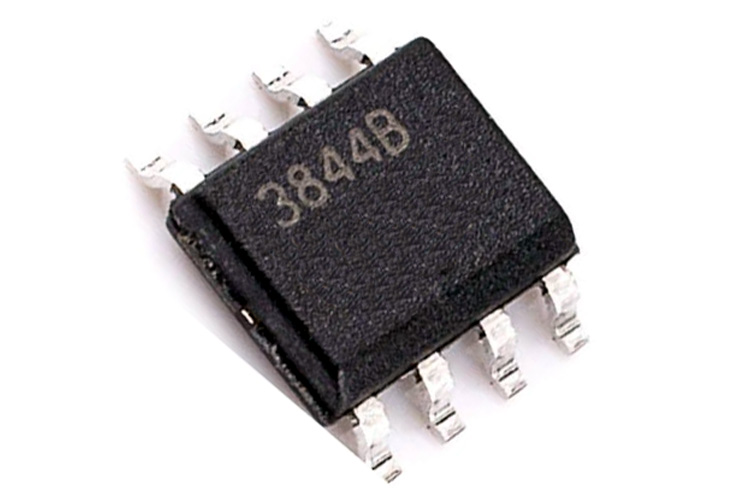

UC3844 Pinout
![d3cf30edc511f21ecec3d5cd4e1a5ad4.png _E(91}VXX{TYP~IW]SP9TZY](https://www.xinshop.com/upload/image/content/20231113/d3cf30edc511f21ecec3d5cd4e1a5ad4.png)

UC3845 Pinout
UC3842 vs UC3843 vs UC3844 vs UC3845 CAD Model
UC3842 CAD Model
UC3842 Symbol

UC3842 Footprint

UC3842 3D-Model

UC3843 CAD Model
UC3843 Symbol

UC3843 Footprint

UC3843 3D-Model

UC3844 CAD Model
UC3844 Symbol

UC3844 Footprint
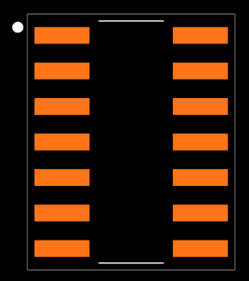
UC3844 3D-Model

UC3845 CAD Model
UC3845 Symbol
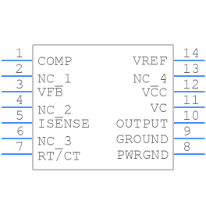
UC3845 Footprint

UC3845 3D-Model

UC3842 vs UC3843 vs UC3844 vs UC3845 Features
While the fundamental architecture remains consistent across the UC384x series, each IC offers distinct features and performance characteristics. These include input voltage range, operating frequency, maximum duty cycle, output drive capability, protection mechanisms, and startup behavior. A detailed comparison of these features is crucial for selecting the most suitable IC for a specific application.
UC3842:
Fixed-frequency PWM controller.
Voltage reference accuracy: ±1%.
Typically used in offline and DC-DC converter applications.
Soft start function for controlled startup.
Current sense input for overcurrent protection.
Error amplifier for voltage feedback regulation.
Low startup and operating current.
Pulse-by-pulse current limiting.
Under-voltage lockout (UVLO) protection.
Oscillator frequency range: 50 kHz to 500 kHz (approximate).
UC3843:
Similar features to UC3842 with some differences:
Voltage reference accuracy: ±0.5%.
Suitable for applications requiring tighter voltage regulation.
Used in offline and DC-DC converter applications.
Soft start, current sense input, error amplifier, low startup and operating current, pulse-by-pulse current limiting, UVLO protection, and oscillator frequency range similar to UC3842.
UC3844:
Similar features to UC3843 with the addition of:
Totem pole output stage for better drive capability.
Suitable for driving power MOSFETs or IGBTs.
Soft start, current sense input, error amplifier, low startup and operating current, pulse-by-pulse current limiting, UVLO protection, and oscillator frequency range similar to UC3843.
UC3845:
Similar features to UC3844 with some differences:
Voltage reference accuracy: ±1%.
Suitable for applications requiring better voltage regulation.
Soft start, current sense input, error amplifier, low startup and operating current, pulse-by-pulse current limiting, UVLO protection, and oscillator frequency range similar to UC3844.
UC3842 vs UC3843 vs UC3844 vs UC3845 Applications
The UC384x series finds extensive use in a wide range of SMPS applications, such as offline power supplies, battery chargers, LED drivers, and DC-DC converters. Their versatility, robustness, and compatibility with various power supply topologies make them suitable for both low-power and high-power designs. The choice among the ICs depends on the specific requirements of the application, such as power level, efficiency, and cost.
The UC384x series ICs are commonly used in various power supply applications, including offline and DC-DC converters. They are utilized in applications such as:
Switched-Mode Power Supplies (SMPS): The UC384x ICs are widely employed in the design of SMPS for computer monitors, televisions, industrial power supplies, and other electronic devices.
Battery Chargers: These ICs can be used as controllers for battery charging circuits, providing efficient and controlled charging of batteries.
LED Drivers: The UC384x series is also suitable for driving LED arrays in lighting applications, ensuring accurate current control and dimming capabilities.
UC3842 vs UC3843 vs UC3844 vs UC3845 Equivalent
In addition to the original UC384x series, several manufacturers offer functionally equivalent ICs that exhibit similar characteristics and performance. These equivalents may have different part numbers but are designed to be drop-in replacements, allowing for flexibility in sourcing and supply chain management.
UC3841 ,UC3846 ,UC3847
UC3842 vs UC3843 vs UC3844 vs UC3845 Block Diagram
The block diagrams of UC3842 vs UC3843 vs UC3844 vs UC3845 ICs illustrate the internal circuitry and how different functional blocks are interconnected. They typically include the error amplifier, oscillator, voltage reference, current-sensing comparator, and output stage.
UC3842
UC3843
UC3844
UC3845
UC3842 vs UC3843 vs UC3844 vs UC3845 Where to Use
The UC384x series is widely used in various applications where efficient power conversion is required. These ICs are commonly employed in offline power supplies, battery chargers, LED lighting systems, motor drives, and DC-DC converters. The choice among the different ICs depends on factors such as power level, efficiency requirements, and cost considerations.
UC3842 vs UC3843 vs UC3844 vs UC3845 How to Use
To utilize the UC3842, UC3843, UC3844, or UC3845 in a circuit, it is essential to carefully follow the guidelines provided in the respective datasheets. These datasheets outline the recommended application circuitry, component values, and layout considerations. Designers should pay attention to the IC's pin assignments, power supply requirements, compensation network design, and external component selection. Additionally, the datasheets often provide application notes and reference designs to assist engineers in implementing these ICs effectively.
UC3842 vs UC3843 vs UC3844 vs UC3845 Package
The UC3842, UC3843, UC3844, and UC3845 ICs are typically available in industry-standard packages, such as 8-pin DIP (Dual In-Line Package), SOIC (Small Outline Integrated Circuit), or PDIP (Plastic Dual In-Line Package). The specific package options may vary depending on the manufacturer. Designers should choose the package that best suits their application requirements, considering factors such as board space, thermal considerations, and assembly processes.
Conclusion
In conclusion, the UC3842, UC3843, UC3844, and UC3845 are highly versatile PWM controllers that find extensive use in various power supply applications. Understanding their unique features, specifications, and application guidelines is crucial for selecting the most suitable IC for a particular design. By leveraging the information provided in the datasheets and considering the specific requirements of the application, engineers can successfully utilize these ICs to achieve efficient and reliable power conversion.
Product comparison
-
ImagePart NumberManufacturerToleranceVoltage - RatedProduct StatusPackage / CaseProduct CategoryView Compare
-
2%
-
-
8-DIP (0.300, 7.62mm)
AC DC Converters, Offline Switches
-
-
-
-
8-SOIC (0.154, 3.90mm Width)
DC DC Switching Controllers
-
-
-
-
8-SOIC (0.154, 3.90mm Width)
DC DC Switching Controllers
-
-
-
-
8-SOIC (0.154, 3.90mm Width)
DC DC Switching Controllers

Frequently Asked Questions
How to calculate the reference frequency on uc3842?
To calculate the reference frequency on the UC3842, you can follow these steps: Determine the desired switching frequency for your application. Let's say, for example, you want a switching frequency of 100 kHz. The UC3842 is a pulse width modulation (PWM) controller that uses an internal oscillator to generate the switching frequency. The frequency is determined by an external timing resistor (RT) and timing capacitor (CT) connected to the appropriate pins on the IC. Refer to the datasheet of the UC3842 for the equation that relates the timing resistor and timing capacitor to the reference frequency. In this case, the equation is: f_ref = 1.0 / (0.693 * RT * CT) Where: f_ref is the reference frequency in Hz. RT is the timing resistor in ohms. CT is the timing capacitor in farads. Rearrange the equation to solve for the timing resistor (RT): RT = 1.0 / (0.693 * f_ref * CT) Substitute the desired switching frequency (100 kHz) and the value of the timing capacitor you plan to use into the equation. For example, if you choose a timing capacitor of 1 nF (0.000000001 F), the calculation would be: RT = 1.0 / (0.693 * 100000 Hz * 0.000000001 F) Calculate the value of the timing resistor (RT) based on the equation. In this case, the result will be in ohms.
-
1,000+Daily Order Quantity
-
2,500,000+Alternative Parts
-
2,200+Worldwide Manufacturers
-
10,000 ㎡In-stock Warehouse










